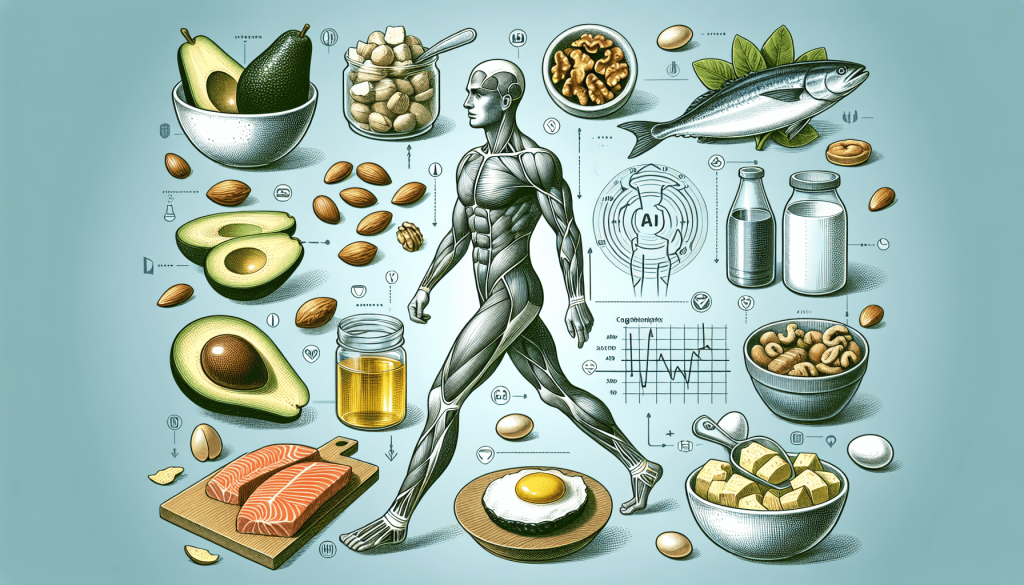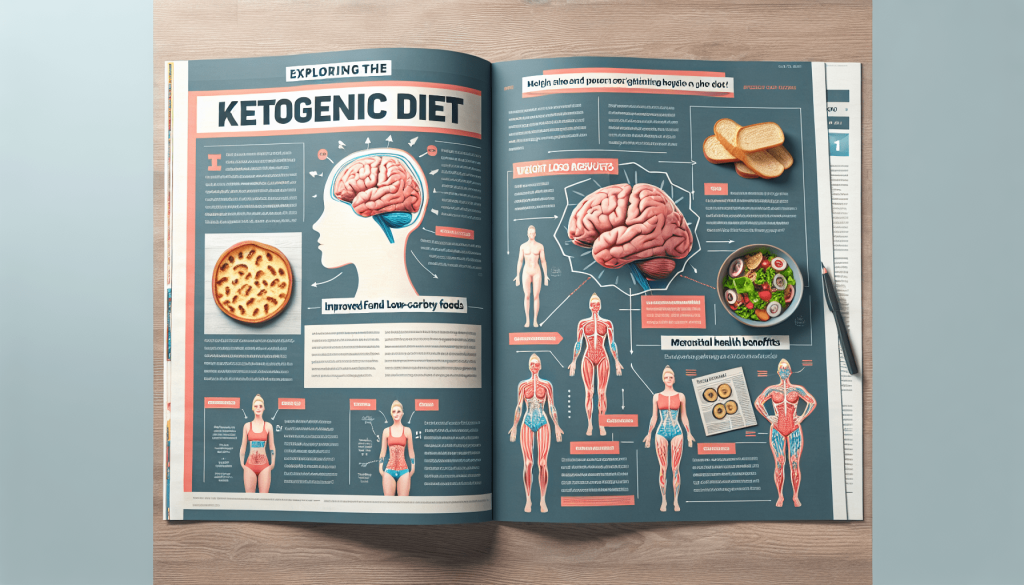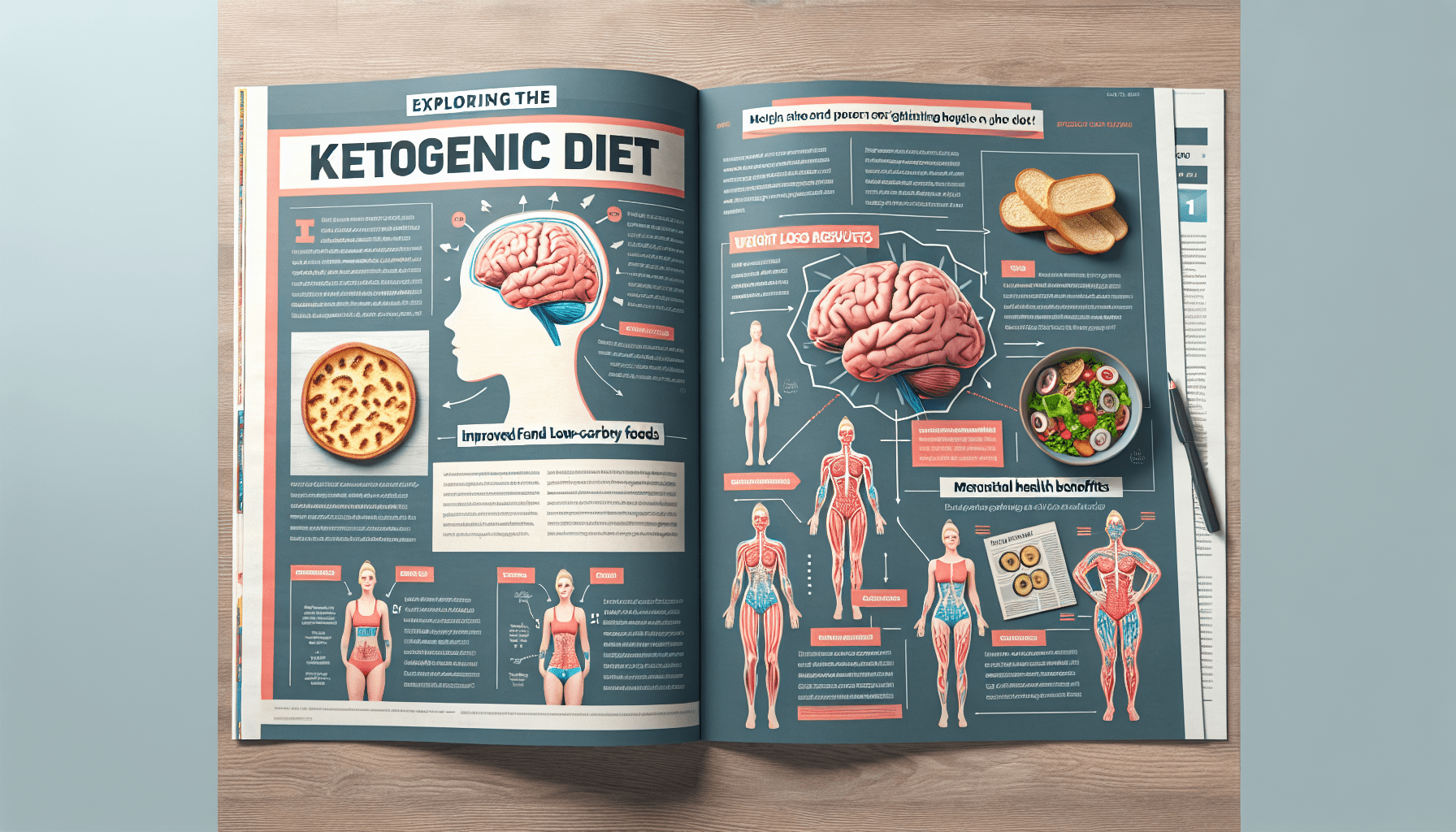You’re about to embark on a journey of discovering the wonderful world of the ketogenic diet. This article provides you with an informative overview of this increasingly popular eating plan, highlighting both its numerous benefits and fundamental principles. Whether you’re curious about weight loss, improved mental focus, or increased energy levels, the ketogenic diet offers a promising solution. So, get ready to explore the ins and outs of this fascinating dietary approach.

Overview of the Ketogenic Diet
Definition and Background
The Ketogenic Diet, or Keto Diet for short, is a low-carb, high-fat diet that has gained popularity for its potential health benefits and ability to aid in weight loss. It was initially developed in the 1920s as a therapeutic diet for children with epilepsy. However, in recent years, it has gained attention as a way to improve insulin sensitivity, promote weight loss, and enhance mental focus.
How the Ketogenic Diet Works
The Ketogenic Diet works by changing the way your body utilizes energy. Normally, your body relies on carbohydrates as its primary source of fuel. However, when you restrict carbohydrate intake, your body enters a metabolic state called ketosis. In ketosis, your body starts using stored fat as its main source of energy, which can result in weight loss.
Benefits of the Ketogenic Diet
The Ketogenic Diet offers a range of potential benefits. Firstly, it can promote weight loss, as the low carbohydrate intake coupled with increased fat burning can lead to a calorie deficit. The diet has also been shown to improve insulin sensitivity, making it beneficial for individuals with type 2 diabetes or metabolic syndrome. Additionally, the Ketogenic Diet may reduce inflammation, enhance mental focus, and potentially reduce the risk of chronic diseases.
Drawbacks and Potential Risks
While the Ketogenic Diet offers numerous benefits, it is important to be aware of the potential drawbacks and risks. The diet requires strict adherence to a low-carb, high-fat eating plan, which can be challenging for some individuals. Certain side effects, such as initial fatigue, known as the “keto flu,” may also occur during the transition to ketosis. It is important to monitor nutrient intake and ensure adequate consumption of micronutrients to prevent deficiencies.
Types of Ketogenic Diets
There are several variations of the Ketogenic Diet to suit individual preferences and goals. The Standard Ketogenic Diet (SKD) is the most common and involves consuming a very low-carb, moderate-protein, and high-fat diet. The Cyclical Ketogenic Diet (CKD) incorporates periods of higher carbohydrate intake, typically in the form of “carb-loading” days. The Targeted Ketogenic Diet (TKD) allows for small amounts of carbohydrates to be consumed before or after workouts to support exercise performance.
Nutritional Principles of the Ketogenic Diet
Macronutrient Ratio
The key principle of the Ketogenic Diet is manipulating macronutrient intake. The standard macronutrient ratio for the Ketogenic Diet is approximately 75% fat, 20% protein, and 5% carbohydrates. This macronutrient distribution helps to induce and maintain ketosis, the metabolic state in which the body primarily uses fat for energy.
Sources of Fat
Since the Ketogenic Diet emphasizes high-fat intake, it is essential to choose healthy sources of fat. Some excellent sources include avocados, nuts and seeds, olive oil, coconut oil, and fatty fish such as salmon. These sources provide essential fatty acids, antioxidants, and other beneficial compounds.
Sources of Protein
Protein is a crucial component of the Ketogenic Diet, but it should be consumed in moderate amounts. Good sources of protein include lean meats, poultry, fish, eggs, and plant-based proteins such as tofu and tempeh. It is essential to choose high-quality protein sources to ensure adequate intake of essential amino acids.
Limited Carbohydrate Intake
Carbohydrates are restricted in the Ketogenic Diet to induce and maintain ketosis. Low-carb vegetables such as leafy greens, broccoli, cauliflower, and zucchini are excellent choices. Even though carbohydrates are limited, it is important to prioritize fibrous, nutrient-dense sources to promote overall health.
Micronutrient Considerations
While the focus of the Ketogenic Diet is primarily on macronutrients, it is crucial to consider micronutrient intake as well. Since certain micronutrients may be lacking in a ketogenic diet, incorporating a variety of vegetables, including those rich in vitamins and minerals, is essential. Additionally, considering supplementation or consulting with a healthcare professional can help ensure nutrient needs are met.
Common Foods in a Ketogenic Diet
Healthy Fats and Oils
To meet the high-fat requirements of the Ketogenic Diet, incorporating healthy fats and oils is crucial. Avocados, nuts and seeds, olive oil, coconut oil, and grass-fed butter are all excellent choices. These fats provide energy, support satiety, and contribute to overall health.
Quality Sources of Protein
Consuming protein from high-quality sources is important on the Ketogenic Diet. Lean meats such as chicken, turkey, and grass-fed beef are good options. Fatty fish like salmon and trout not only provide protein but also offer beneficial omega-3 fatty acids. Plant-based protein sources such as tofu, tempeh, and legumes can be included for individuals following a vegetarian or vegan Ketogenic Diet.
Low-Carb Vegetables
Low-carb vegetables are a staple in the Ketogenic Diet. Leafy greens like spinach and kale, cruciferous vegetables such as broccoli and cauliflower, and zucchini are all great choices. These vegetables provide vitamins, minerals, and fiber while keeping carbohydrate intake low.
Nuts and Seeds
Nuts and seeds are versatile and nutritious additions to a Ketogenic Diet. Almonds, walnuts, chia seeds, and flaxseeds are rich in healthy fats, fiber, and beneficial antioxidants. They can be enjoyed as snacks, added to meals or used as toppings.
Dairy Products
Dairy products can be consumed in moderation on the Ketogenic Diet. Full-fat options such as cheese, yogurt, and cream are suitable choices as they are low in carbohydrates and provide essential nutrients like calcium and vitamin D.
Beverages and Sweeteners
When it comes to beverages, water should be the primary choice on the Ketogenic Diet. Coffee, tea, and herbal infusions without added sugars or milk can also be enjoyed. Sweeteners such as stevia and erythritol, which do not impact blood sugar levels, can be used in moderation to satisfy sweet cravings.
Meal Planning and Preparation
Determining Calorie and Macronutrient Needs
To effectively follow the Ketogenic Diet, it is important to determine your individual calorie and macronutrient needs. Online calculators or consultation with a healthcare professional or registered dietitian can help establish a goal caloric intake and macronutrient distribution.
Designing Balanced and Nutritious Meals
When planning meals on the Ketogenic Diet, aim for a balance of healthy fats, quality protein sources, and low-carb vegetables. Incorporating a variety of colorful vegetables can provide a wide range of micronutrients. Experimenting with different recipes and meal ideas can help keep meals exciting and enjoyable.
Sample Meal Plans
Sample meal plans can provide guidance and inspiration when starting the Ketogenic Diet. These plans typically include breakfast, lunch, dinner, and snacks and may vary based on individual preferences and nutritional needs. It is important to customize meal plans to suit your dietary goals and taste preferences.
Meal Prepping Tips
Meal prepping can be a helpful strategy to ensure adherence to the Ketogenic Diet. By preparing meals in advance, you can save time and have readily available options that align with your macronutrient goals. Utilize food storage containers, plan meals for the week, and batch cook ingredients to make meal preparation more efficient.

Combining the Ketogenic Diet with Exercise
Introduction to Exercise on a Ketogenic Diet
Combining the Ketogenic Diet with exercise can have synergistic effects on health and fitness goals. Exercise can help improve insulin sensitivity, boost metabolism, aid in weight loss, and enhance overall well-being. When engaging in physical activity on the Ketogenic Diet, it is important to make necessary adjustments to fuel your body adequately.
Best Types of Exercise
The best types of exercise on a Ketogenic Diet are ones that are sustainable, enjoyable, and align with your fitness goals. Strength training, cardiovascular exercises like jogging or cycling, and low-intensity activities such as yoga or walking are all suitable options. Finding a balance between aerobic and resistance exercises can promote overall fitness and body composition changes.
Timing of Exercise and Food Intake
Timing exercise and food intake can be important on the Ketogenic Diet. Some individuals find it beneficial to exercise in a fasted state, while others may prefer to consume a small snack before or after their workouts. Experimenting with different timing strategies can help optimize energy levels and performance during exercise.
Preventing and Managing Fatigue
During the initial adaptation phase of the Ketogenic Diet, it is common to experience fatigue or low energy levels. This is often referred to as the “keto flu.” To prevent and manage fatigue, ensure adequate hydration, consume sufficient electrolytes, and gradually increase exercise intensity as your body becomes keto-adapted.
Supplements for Enhanced Performance
Supplements can be used to enhance exercise performance on the Ketogenic Diet. Branched-chain amino acids (BCAAs) can help support muscle recovery and reduce muscle breakdown. Creatine supplementation may also be beneficial for improving strength and power output. Consult with a healthcare professional or registered dietitian before incorporating any supplements into your regimen.
Health and Weight Loss Benefits
Reduced Inflammation
The Ketogenic Diet has been shown to reduce inflammation in the body. By minimizing consumption of processed foods, sugar, and refined carbohydrates, and increasing intake of anti-inflammatory fats and antioxidants, the risk of chronic inflammation can be reduced. This can have positive implications for overall health and disease prevention.
Improved Insulin Sensitivity
Insulin sensitivity refers to the body’s ability to effectively respond to insulin and control blood sugar levels. Following a Ketogenic Diet can improve insulin sensitivity, making it an effective dietary approach for individuals with type 2 diabetes or metabolic syndrome. By reducing carbohydrate intake and lowering circulating glucose levels, the body’s response to insulin improves.
Weight Loss and Management
One of the primary reasons why people choose to follow the Ketogenic Diet is for weight loss. The reduction in carbohydrate intake and increase in fat burning can result in a calorie deficit, leading to weight loss. Additionally, the diet promotes satiety and can help control appetite, making it easier to adhere to a calorie-restricted eating plan.
Increased Energy Levels
Once the body becomes adapted to using fat as its primary fuel source, many individuals experience increased energy levels on the Ketogenic Diet. This is due to the steady supply of energy from stored fat. By avoiding blood sugar crashes and relying on a more stable energy source, sustained energy levels can be maintained throughout the day.
Enhanced Mental Focus
The Ketogenic Diet has been shown to enhance mental focus and clarity. When in ketosis, the brain primarily uses ketones for fuel instead of glucose. This stable and efficient energy source can result in improved cognitive function, enhanced concentration, and increased mental clarity.
Reduced Risk of Chronic Diseases
Several studies have suggested that the Ketogenic Diet may reduce the risk of chronic diseases. By reducing inflammation, improving insulin sensitivity, and aiding in weight loss, the diet can have a positive impact on various disease risk factors. However, further research is still needed to fully understand the long-term effects on chronic disease prevention.
Who Should Follow a Ketogenic Diet?
Epilepsy Patients
The Ketogenic Diet was initially developed as a therapeutic diet for epilepsy patients, particularly children. It has been shown to reduce the frequency and severity of seizures in some individuals. If you or your child have epilepsy, it is essential to consult with a healthcare professional before implementing the Ketogenic Diet.
Type 2 Diabetes
For individuals with type 2 diabetes, the Ketogenic Diet may be a beneficial dietary approach. By reducing carbohydrate intake and regulating blood sugar levels, it can improve insulin sensitivity and help manage blood glucose levels. However, close monitoring and guidance from a healthcare professional are important when making any dietary changes.
Metabolic Syndrome
Metabolic syndrome is a cluster of conditions that increase the risk of heart disease, stroke, and type 2 diabetes. These conditions include high blood pressure, high blood sugar, excess body fat around the waist, and abnormal cholesterol levels. The Ketogenic Diet can be helpful in managing metabolic syndrome by addressing the underlying risk factors.
Weight Loss Seekers
The Ketogenic Diet has gained popularity as a weight loss approach. By restricting carbohydrate intake and promoting fat burning, it can facilitate weight loss and help individuals achieve their weight loss goals. However, it is important to note that long-term success relies on overall lifestyle changes and adherence to a balanced, nutrient-rich diet.
Athletes and Fitness Enthusiasts
While the Ketogenic Diet may not be suitable for all athletes, it can be beneficial for specific individuals. Endurance athletes who rely on fat oxidation as a fuel source may benefit from a well-formulated Ketogenic Diet. However, those engaging in high-intensity, anaerobic activities may find carbohydrates essential for optimal performance. It is important to consult with a healthcare professional or registered dietitian to determine the best approach for your specific athletic needs.
Important Considerations and Cautions
Initial Side Effects
When starting the Ketogenic Diet, it is common to experience some initial side effects. These can include fatigue, headaches, dizziness, irritability, and constipation. These side effects may occur during the transition phase as the body adapts to using fat as its primary fuel source. Most side effects subside within a few days to a few weeks.
Keto Flu
The “keto flu” refers to a group of symptoms that some individuals experience when transitioning to a Ketogenic Diet. These symptoms may include fatigue, headache, nausea, dizziness, and brain fog. It is important to stay adequately hydrated, consume sufficient electrolytes, and gradually transition into the diet to minimize the severity of these symptoms.
Potential Nutrient Deficiencies
Following a strict Ketogenic Diet may put individuals at risk of certain nutrient deficiencies. Since carbohydrates are restricted, sources of vitamins, minerals, and fiber typically found in fruits, whole grains, and legumes become limited. It is important to ensure a variety of low-carb vegetables and consider supplementation if necessary to meet all nutrient needs.
Individual Variations
Every individual is unique, and what works for one person may not work for another. Some individuals may thrive on a Ketogenic Diet, while others may not find it sustainable. It is essential to listen to your body, monitor how you feel and perform, and make adjustments as needed. Consulting with a healthcare professional or registered dietitian can provide tailored guidance based on individual needs.
Monitoring and Adjusting the Diet
Regular monitoring and adjustment of the Ketogenic Diet are important to ensure optimal results and minimize potential risks. Regularly checking ketone levels through blood, urine, or breath tests can help determine if you are in a state of ketosis. Fine-tuning macronutrient ratios, evaluating nutrient intake, and monitoring any potential side effects can help optimize the Ketogenic Diet for individual needs.
Long-Term Sustainability and Maintenance
Transitioning to a Balanced Diet
While the Ketogenic Diet can provide short-term benefits and weight loss, it is not intended to be a long-term, sustainable eating plan for all individuals. Once you have achieved your desired goals, transitioning to a more balanced and varied diet can offer the benefits of whole grains, fruits, legumes, and a wider range of nutrients.
Cyclical Ketogenic Dieting
For some individuals, a Cyclical Ketogenic Diet (CKD) may be a more sustainable approach. This involves cycling between periods of strict ketosis and higher carbohydrate intake. CKD can provide flexibility while still allowing individuals to reap the benefits of ketosis. It is important to tailor the duration and timing of carb-loading phases to individual goals and preferences.
Ketogenic Diet Maintenance Tips
To maintain the benefits of the Ketogenic Diet long-term, it is important to adhere to some key principles. Prioritizing whole, unprocessed foods, monitoring carbohydrate intake, and paying attention to overall calorie intake can help maintain weight loss and overall health. Regular exercise, sufficient sleep, and stress management are also important factors to consider for optimal results.
Consulting with Healthcare Professionals
Medical Supervision
If you have underlying medical conditions or are on medication, it is essential to consult with a healthcare professional before starting the Ketogenic Diet. They can provide personalized advice, monitor your progress, and ensure the diet is implemented safely and effectively. Regular check-ups can help track any potential changes in health markers.
Interactions with Medications
The Ketogenic Diet can interact with certain medications, so it is necessary to inform your healthcare professional about any medications you are taking before starting the diet. Medications for diabetes, blood pressure, and cholesterol may require adjustment as the diet can have an impact on these conditions.
Pre-existing Medical Conditions
Individuals with pre-existing medical conditions such as liver or kidney disease, pancreatitis, gallbladder issues, or a history of disordered eating should exercise caution when considering the Ketogenic Diet. It is important to consult with a healthcare professional to assess whether the diet is suitable and safe for your specific condition.
Pregnancy and Breastfeeding
The Ketogenic Diet is not recommended during pregnancy or breastfeeding. These periods require adequate nutrition and a well-balanced diet to support the health of both the mother and the baby. Consult with a healthcare professional or registered dietitian to develop a suitable eating plan for this stage of life.
In conclusion, the Ketogenic Diet is a low-carb, high-fat eating plan that offers numerous potential benefits. From weight loss and improved insulin sensitivity to increased energy levels and enhanced mental focus, the diet has gained popularity for its positive effects on health and well-being. However, it is important to consider potential risks, individual variations, and consult with healthcare professionals to ensure safety and optimize results. By following the principles and guidelines outlined in this article, you can embark on a successful and sustainable Ketogenic Diet journey.
